- Home
- L. Frank Baum
The Santa Claus Stories
The Santa Claus Stories Read online
Book Description
Collected here are five engaging and enduring tales of Santa Claus from the pen of children’s author L. Frank Baum, best known for his Land of Oz series. From “Little Bun Rabbit,” who visited Santa’s workshop, to the Wogglebug and his friends from the Sunday paper comic pages making toys for Santa to give to children everywhere, Baum created a legacy that has lived in our hearts for more than a century.
Writing to entertain his own children, Baum also captured the imaginations of children across the globe with his images of Santa and his reindeer, stockings by the chimney, and a magical trip around the world in a single night.
Here, in The Life and Adventures of Santa Claus, will you learn how Claus found his life’s mission making children happy, how he became the Patron Saint of Children, and how he earned immortality.
In the short story, “A Kidnapped Santa Claus,” you’ll discover what happens when Claus is taken—on Christmas eve as he’s starting his journey!—by Daemons who are determined to deny joy to the children of the world and instead spread Envy, Selfishness, Malice, and Hatred.
This excerpt from The Road to Oz brings Santa to Princess Ozma’s birthday party in Emerald City. He knows all the children, of course, including Dorothy, who’s come to visit with her dog Toto.
Baum’s Santa stories may have been written for children, but they will appeal to anyone of any age who still understands the magic and joy of Christmas.
The Santa Claus Stories
L. Frank Baum
The Santa Claus Stories
L. Frank Baum
Foreword by Dean Wesley Smith
Introduction by James Romag
This compilation © 2020 WordFire Press
Original publication information listed at end of book.
All rights reserved. No part of this book may be reproduced or transmitted in any form or by any electronic or mechanical means, including photocopying, recording or by any information storage and retrieval system, without the express written permission of the copyright holder, except where permitted by law. This novel is a work of fiction. Names, characters, places and incidents are either the product of the author’s imagination, or, if real, used fictitiously.
The ebook edition of this book is licensed for your personal enjoyment only. The ebook may not be re-sold or given away to other people. If you would like to share the ebook edition with another person, please purchase an additional copy for each recipient. Thank you for respecting the hard work of this author.
EBook ISBN: 978-1-68057-103-5
Trade Paperback ISBN: 978-1-68057-102-8
Hardcover ISBN: 978-1-68057-104-2
* * *
Edited by James Romag
Cover design by James Romag and Janet McDonald
Cover artwork image by Mary Cowles Clark, from The Life and Adventures of Santa Claus
* * *
Published by
WordFire Press, LLC
PO Box 1840
Monument CO 80132
Kevin J. Anderson & Rebecca Moesta, Publishers
WordFire Press eBook Edition 2020
WordFire Press Trade Paperback Edition 2020
WordFire Press Hardcover Edition 2020
Printed in the USA
Join our WordFire Press Readers Group for
sneak previews, updates, new projects, and giveaways.
Sign up at wordfirepress.com
Contents
Foreword
Introduction
Untitled Christmas Poem
Little Bun Rabbit
Preface
Little Bun Rabbit
The Life and Adventures of Santa Claus
Preface
The Life and Adventures of Santa Claus
Part I YOUTH
1. Burzee
2. The Child of the Forest
3. The Adoption
4. Claus
5. The Master Woodsman
6. Claus Discovers Humanity
7. Claus Leaves the Forest
Part II MANHOOD
1. The Laughing Valley
2. How Claus Made the First Toy
3. How the Ryls Colored the Toys
4. How Little Mayrie Became Frightened
5. How Bessie Blithesome Came to the Laughing Valley
6. The Wickedness of the Awgwas
7. The Great Battle Between Good and Evil
8. The First Journey with the Reindeer
9. “Santa Claus!”
10. Christmas Eve
11. How the First Stockings Were Hung by the Chimneys
12. The First Christmas Tree
Part III OLD AGE
1. The Mantle of Immortality
2. When the World Grew Old
3. The Deputies of Santa Claus
A Kidnapped Santa Claus
Preface
A Kidnapped Santa Claus
(Excerpt from) The Road to Oz
Preface
(Excerpt from) The Road to Oz
1. Important Arrivals
2. The Grand Banquet
3. The Birthday Celebration
How the Wogglebug and His Friends Visited Santa Claus
Preface
How the Wogglebug and His Friends Visited Santa Claus
Original Publication Information
About the Author and Illustrators
If You Liked …
Other WordFire Press Titles
Foreword
Dean Wesley Smith
James Romag is the editor of this fantastic volume of stories from the master storyteller L. Frank Baum. And James has done an amazing job bringing back to light some lost works of a great author who was responsible for so much cultural history that so many of us just take for granted.
When you mention to someone that L. Frank Baum had a major influence on the holiday of Christmas we now celebrate, that person will just look at you with a puzzled expression. In this single volume, James has done a service for all of us by bringing Baum’s fantastic Christmas stories together for, as far as I know, the first time ever.
This book will be a treasure for you and something to read to your children during the holidays.
Now, let me have James Romag explain the history of Baum’s stories and why this book is so important to our modern culture. So read and enjoy all the wonderful stories. I know I sure did.
* * *
Dean Wesley Smith is a USA Today bestselling American author who’s published more than 200 novels and hundreds of short stories in mystery, fantasy, science fiction, and multiple other genres. During his career, Dean also wrote a couple dozen Star Trek novels, the only two original Men in Black novels, and Spider-Man and X-Men novels, plus novels set in gaming and television worlds. He can be found at deanwesleysmith.com.
Introduction
James Romag
Known the world over for his Land of Oz series, American author Lyman Frank Baum was equally successful penning other fantasy tales for children. Well over a century ago, Baum sat down and wrote a handful of narratives that not only entertained in the moment but lived on and helped forge our collective popular image of the legend known as Santa Claus.
There were other American authors, of course, who wrote of Santa, or Saint Nicholas, before Baum took his turn. Washington Irving mentioned St. Nicholas in his 1809 satire piece “Knickerbocker’s History of New York.” In “History,” Irving includes a brief passage regarding St. Nicholas, who “came riding over the tops of the trees, in that self-same wagon wherein he brings his yearly presents to children.” When it was time to leave, St. Nicholas lay “his finger beside his nose” and returned over the treetops. Little else is said of St. Nicholas in “History,” however, and Irving�
�s 1876 “Old Christmas” makes no mention of Saint Nicholas at all.
Clement Clarke Moore (or perhaps it was Henry Livingston, Jr.) drafted “A Visit from St. Nicholas” in 1823. That holiday poem, as everyone knows, gave us a chubby and plump St. Nick driving a miniature sleigh with eight tiny reindeer on his travels to fill children’s stockings hung by the chimney.
But it was Baum’s pen that really captivated our imagination and shaped our modern impression of Santa Claus. Beginning with his “Little Bun Rabbit” short story from Mother Goose in Prose in 1897, Baum tells of Santa and his reindeer taking toys to children on a miraculous journey around the world in a single night, arriving back home before dawn.
In 1902’s The Life and Adventures of Santa Claus, Baum recounts the full tale of Santa, from his abandonment in the Forest of Burzee and subsequent adoption by a wood-nymph named Necile, to his visits on the cities of mankind where he saw the suffering of the children and vowed to make them happy, to his growing old, heavy, and gray before being granted immortality.
Life and Adventures explains how Claus got his name: “… let him be called Neclaus … for that will mean ‘Necile’s little one.’” From Neclaus came Nicklaus or Nicolas, “which is the reason that Santa Claus is still known in some lands as St. Nicolas.” It’s also in Life and Adventures where we witness Claus making his first toy of many—carving a cat from wood—and eventually becoming the Patron Saint of Children, or Santa Claus.
Baum’s lasting voice filled our heads with the sound of sleigh bells and thoughts of reindeer pulling a sledge full of toys for children, with visions of the old fellow making his way down chimneys to drop gifts into stockings hung by the fireplace, and with the echo of Santa calling out, “Ho, ho, ho!” as he carried out his duties. Baum told us how Santa brought Christmas trees to so many homes and why he deputized parents to help him on Christmas eve, all in his quest to bring joy to children around the world.
As the short story “A Kidnapped Santa Claus” from 1904 shows us, nothing can stop Santa’s good will. When he’s taken by Daemons, his immortal friends—a Ryl, a Knook, a Pixie, and a Fairy—take up Santa’s mission to make children happy and deliver his toys, though not without a few mistakes.
Further solidifying the modern image of Santa, when he visits Princess Ozma for her birthday in 1909’s The Road to Oz, Baum describes him as “round as an apple, with a fresh rosy face, laughing eyes, and a bushy beard as white as snow,” with a “red cloak trimmed with beautiful ermine.”
To be sure, not all of Baum’s work has become lore. In “Little Bun Rabbit,” Santa lived atop a mountain in a castle of gold and silver with windows made of diamond where Mother Hubbard served his meals. In other tales, Santa lived in the Laughing Valley of Hohaho and had ten reindeer pulling his sledge each year. Those reindeer, by the way, never flew, but traveled swiftly in great leaps. And with nary an elf in sight in any of the stories, Santa made all the toys himself, though he did have help from some fairies getting toys into any houses without proper chimneys.
Baum’s classic holiday tales have rightfully endured for more than a hundred years and those five stories are now collected in one volume, the appropriately titled The Santa Claus Stories of L. Frank Baum, to be enjoyed any time of the year. Here’s to those ten reindeer—Flossie and Glossie, Racer and Pacer, Reckless and Speckless, Fearless and Peerless, and Ready and Steady—and to anyone who’s ever believed in Santa Claus.
Special thanks to Marcus Mebes from The International Wizard of Oz Club (ozclub.org) and Chris Glasgow, curator of the Oz Museum (ozmuseum.com), for their assistance in this compilation.
Untitled Christmas Poem
Santa Claus was good to me—
Gave me lots of things
Wrapped in dainty parcels
And tied with ribbon-strings.
* * *
I can’t recall what lovely gifts
Within there chanced to be—
The wrappers and the ribbons
Were what are dear to me.
* * *
They breathe of sweet remembrance,
Of Love and Kindly Thought—
The things about my presents
That never could be bought.
* * *
And so, although I’m far away,
Love’s message spans the space
And our two hearts are linked anew
Through dear old Santa’s grace.
Untitled poem by L. Frank Baum, written to his sister, Mary Louise Brewster, published posthumously in Jack Snow’s authorized The Shaggy Man of Oz.
Little Bun Rabbit
Illustrated by Maxfield Parrish
“Little Bun Rabbit” first appeared in 1897’s Mother Goose in Prose.
* * *
I have thought the children might like the (Mother Goose) stories told at greater length, that they may dwell longer upon their favorite heroes and heroines.
For that reason I have written this book.
In making the stories I have followed mainly the suggestions of the rhymes, and my hope is that the little ones will like them, and not find that they interfere with the fanciful creations of their own imaginations.
—L. Frank Baum
Chicago, Illinois
From the introduction to Mother Goose in Prose
Editor’s note: The complete Mother Goose in Prose consists of twenty-two children’s short stories based on Mother Goose nursery rhymes. The final piece in the original collection is “Little Bun Rabbit,” providing Santa’s first appearance in Baum’s stories. “Little Bun Rabbit” includes a character named Dorothy, but this is not the same Dorothy who later came to be known in the Land of Oz series. When “Little Bun Rabbit” was reprinted in his Juvenile Speaker in 1910, Baum changed the name to Doris to avoid confusion with Oz’s Dorothy Gale.
To the extent possible, the text of this story, to include spellings such as “good bye,” is left as Baum originally wrote it.
“Oh, Little Bun Rabbit, so soft and so shy,
“Say, what do you see with your big, round eye?”
“On Christmas we rabbits,” says Bunny so shy,
“Keep watch to see Santa go galloping by.”
Little Dorothy had passed all the few years of her life in the country, and being the only child upon the farm she was allowed to roam about the meadows and woods as she pleased. On the bright summer mornings Dorothy’s mother would tie a sun-bonnet under the girl’s chin, and then she romped away to the fields to amuse herself in her own way.
She came to know every flower that grew, and to call them by name, and she always stepped very carefully to avoid treading on them, for Dorothy was a kind-hearted child and did not like to crush the pretty flowers that bloomed in her path. And she was also very fond of all the animals, and learned to know them well, and even to understand their language, which very few people can do. And the animals loved Dorothy in turn, for the word passed around amongst them that she could be trusted to do them no harm. For the horse, whose soft nose Dorothy often gently stroked, told the cow of her kindness, and the cow told the dog, and the dog told the cat, and the cat told her black kitten, and the black kitten told the rabbit when one day they met in the turnip patch.
Therefore when the rabbit, which is the most timid of all animals and the most difficult to get acquainted with, looked out of a small bush at the edge of the wood one day and saw Dorothy standing a little way off, he did not scamper away, as is his custom, but sat very still and met the gaze of her sweet eyes boldly, although perhaps his heart beat a little faster than usual.
Dorothy herself was afraid she might frighten him away, so she kept very quiet for a time, leaning silently against a tree and smiling encouragement at her timorous companion until the rabbit became reassured and blinked his big eyes at her thoughtfully. For he was as much interested in the little girl as she in him, since it was the first time he had dared to meet a person face to face.
Finally Dorothy ventured to speak, so s
he asked, very softly and slowly,
“Oh, Little Bun Rabbit, so soft and so shy,
“Say, what do you see with your big, round eye?”
“Many things,” answered the rabbit, who was pleased to hear the girl speak in his own language; “in summer-time I see the clover-leaves that I love to feed upon and the cabbages at the end of the farmer’s garden. I see the cool bushes where I can hide from my enemies, and I see the dogs and the men long before they can see me, or know that I am near, and therefore I am able to keep out of their way.”

 The Wonderful Wizard of Oz
The Wonderful Wizard of Oz The Emerald City of Oz
The Emerald City of Oz The Story of Peter Pan, Retold from the fairy play by Sir James Barrie
The Story of Peter Pan, Retold from the fairy play by Sir James Barrie Sky Island
Sky Island Tik-Tok of Oz
Tik-Tok of Oz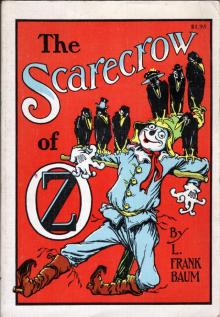 The Scarecrow of Oz
The Scarecrow of Oz The Sea Fairies
The Sea Fairies Glinda of Oz
Glinda of Oz The Lost Princess of Oz
The Lost Princess of Oz The Tin Woodman of Oz
The Tin Woodman of Oz Ozma of Oz
Ozma of Oz The Master Key
The Master Key The Enchanted Island of Yew
The Enchanted Island of Yew Rinkitink in Oz
Rinkitink in Oz The Magic of Oz
The Magic of Oz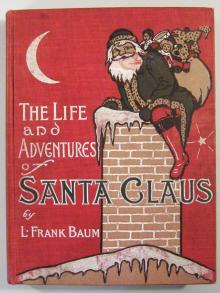 The Life and Adventures of Santa Claus
The Life and Adventures of Santa Claus The Marvelous Land of Oz
The Marvelous Land of Oz The Royal Book of Oz
The Royal Book of Oz The Road to Oz
The Road to Oz Dorothy and the Wizard in Oz
Dorothy and the Wizard in Oz The Patchwork Girl of Oz
The Patchwork Girl of Oz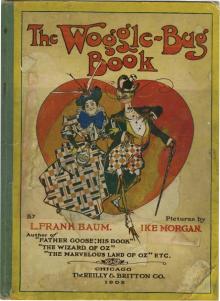 The Woggle-Bug Book
The Woggle-Bug Book Little Wizard Stories of Oz
Little Wizard Stories of Oz Yankee in Oz
Yankee in Oz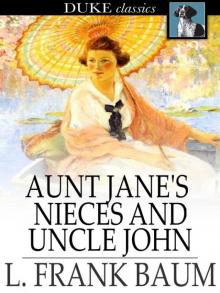 Aunt Jane's Nieces and Uncle John
Aunt Jane's Nieces and Uncle John Mary Louise
Mary Louise Prairie-Dog Town
Prairie-Dog Town Aunt Jane's Nieces at Millville
Aunt Jane's Nieces at Millville John Dough and the Cherub
John Dough and the Cherub Aunt Jane's Nieces in Society
Aunt Jane's Nieces in Society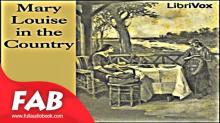 Mary Louise in the Country
Mary Louise in the Country Aunt Jane's Nieces Abroad
Aunt Jane's Nieces Abroad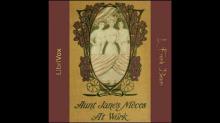 Aunt Jane's Nieces at Work
Aunt Jane's Nieces at Work Aunt Jane's Nieces on the Ranch
Aunt Jane's Nieces on the Ranch Aunt Jane's Nieces in the Red Cross
Aunt Jane's Nieces in the Red Cross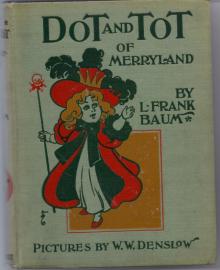 Dot and Tot of Merryland
Dot and Tot of Merryland Aunt Jane's Nieces on Vacation
Aunt Jane's Nieces on Vacation The Giant Horse Of Oz
The Giant Horse Of Oz The Hidden Valley of Oz
The Hidden Valley of Oz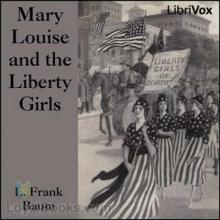 Mary Louise and the Liberty Girls
Mary Louise and the Liberty Girls Mary Louise Solves a Mystery
Mary Louise Solves a Mystery The Santa Claus Stories
The Santa Claus Stories Aunt Judith: The Story of a Loving Life
Aunt Judith: The Story of a Loving Life Aunt Jane's Nieces
Aunt Jane's Nieces Wonderful Wizard of Oz (Barnes & Noble Classics Series)
Wonderful Wizard of Oz (Barnes & Noble Classics Series) Oz, The Complete Collection
Oz, The Complete Collection Complete Works of L. Frank Baum
Complete Works of L. Frank Baum The Wizard of Oz
The Wizard of Oz Oz 10 - Rinkitink in Oz
Oz 10 - Rinkitink in Oz